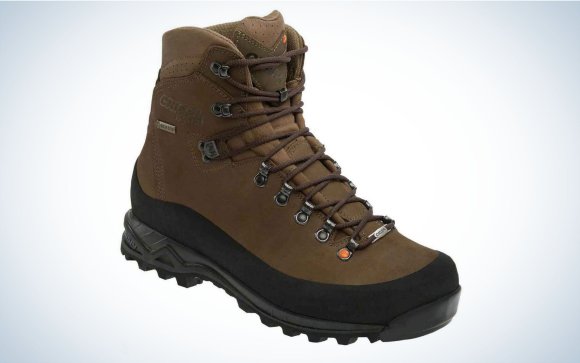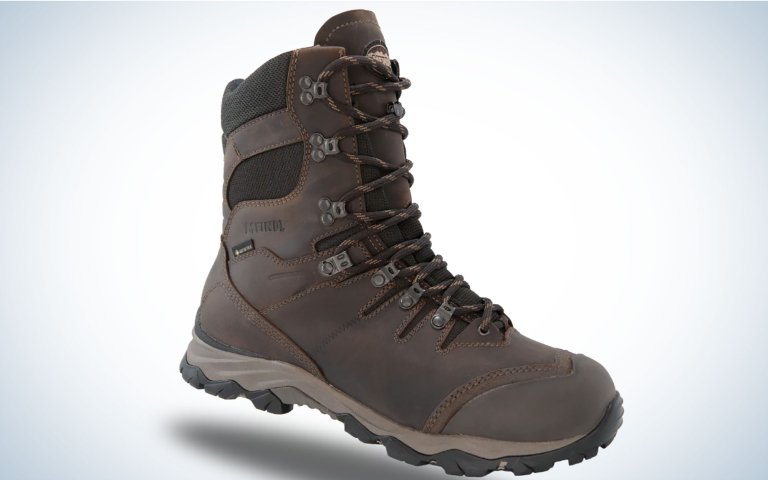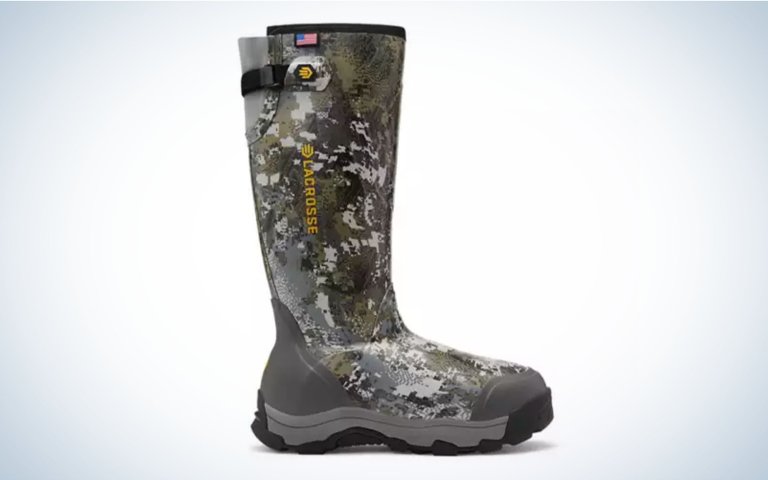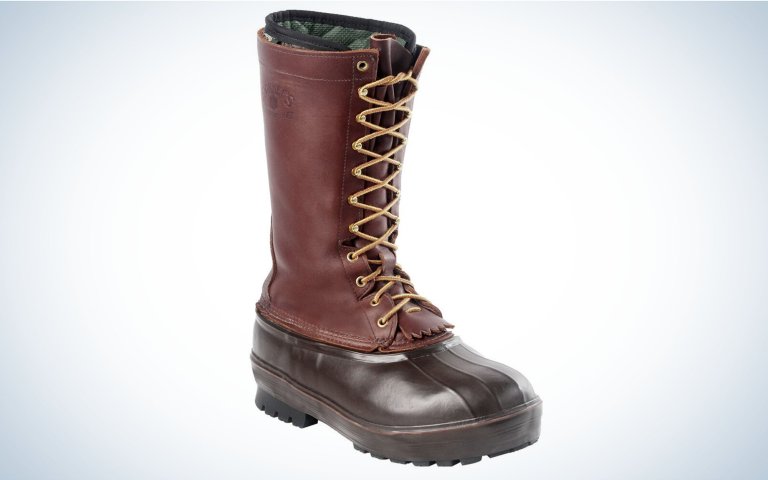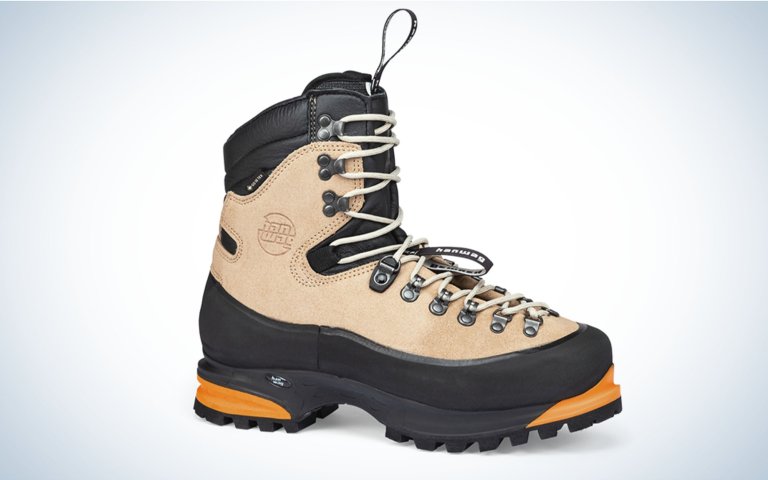We may earn revenue from the products available on this page and participate in affiliate programs. Learn More ›
Ask any experienced hunter about their most important pieces of gear and I’ll guarantee that they rank boots in their top five. That’s because bad boot selection can wreck a good hunt quickly. If your toes are getting frostbitten, you won’t be able to stay in your deer stand until last light. If your feet are blistered and rubbed raw, you won’t be motivated to hike that final ridge on an elk hunt. On the flip side, the best hunting boots mostly go unnoticed while you’re actually hunting. You don’t think about your feet when they aren’t aching, or wet, or cold. As it should be.
Happily, these days there’s a hunting boot design for every type of hunt, terrain, and condition. What we have compiled below is the ultimate buyer’s guide of the best hunting boots for a variety of purposes. If you want to dive into species specific reviews, check out our guides to the best upland hunting boots, best turkey hunting boots, best rubber hunting boots, and best elk hunting boots.
But if you want to peruse the wider world of hunting boots, and pick a pair (or two) that will fit your needs, then check out our selections below.
- Best Overall: Crispi Nevada Non-Insulated GTX
- Great Buy: Oboz Bridger Insulated
- Best Barefoot Boot: Vivobarefoot Tracker ESC
- Most Versatile Hunting Boot: Meindl Eurolight Hunter 300
- Best Every-Day Hunting Boot: Muck Alpha Pursuit Ankle Boot
- Best Deer Hunting Boot: LaCrosse Alpha Evolution
- Most Comfortable Rubber Boot: Muddy Dv8 17
- Best Light Rubber Boot: Le Chameau Chasseur
- Best Elk Hunting Boot: Schnee Granite 200g
- Best Classic Hunting Boot: Danner Pronghorn
- Best Mountain Hunting Boot: Lowa Tibet GTX
- Best Women’s Hunting Boot: Danner Wayfinder
- Best Late-Season Whitetail Boot: Schnee Extreme 13
- Best Early Season Whitetail: Salomon XA Pro 3D
- Best Duck Hunting Boot: Chene Slough Boot
- Best for Extreme Mountain Terrain: HanWag Omega GTX
How We Chose the Best Hunting Boots

We selected our roster of hunting boots by committee. The Outdoor Life staff has hiked and hunted thousands of miles in hundreds of different boots over the years. For this story we each picked our personal favorites for specific uses. Our staff has a wide range of expertises and interests, including backcountry elk hunting, frontcountry deer hunting, sheep hunting in Alaska, waterfowling, thru-hiking, upland bird hunting, and pretty much anything else you might want a hunting boot for. Each of these boots is available on the market today. Some are old favorites; some are new this year. Most importantly we’ve worn each pair in the field. In some cases we have deep experience with predecessors of the new updated boot.
We evaluated each boot for comfort, durability, value, and how well it meets its intended purpose. The boots in this review tend to run on the more expensive side. There are a lot of cheap boots out there, but generally they’re not worth the money. You’re better off going with a spendier boot that will last many seasons rather than burning through cheap boots every few years. Each of the following picks will serve you well for the long run.
Best Hunting Boots: Reviews & Recommendations
Best Overall: Crispi Nevada Non-Insulated GTX
Pros
- Versatile
- Durable
- Comfortable
Cons
- Not the best choice for frigid weather
- 8-inch height can be a limitation in rocky conditions and when traversing water
Key Features
- Height: 8 inches
- Weight: 1.9 pounds each (men’s size 10)
- Upper Material: Water Repellent Nubuk
- Outsole: Vibram
- Made in Italy
There’s no such thing as a do-everything hunting boot. Bog-slogging in Canada for moose to hiking desert shale for aoudad is more ground than any one boot can cover. But the Crispi Nevada comes close—particularly for any adventure that involves vertical.
The hallmark of the Nevada is its combination of comfort and durability, especially when you need to put on the miles.
I’m going into my third season with mine and have used it on hunts around the globe—from Africa to Alberta and Montana to Mongolia. The mid-height (8-inch) construction saves weight, but the boot still has enough support to haul heavy loads out of the mountains.
Crispi says one reason their boots are so comfortable (and have a minimal break-in period) is the combination of their deep heel pocket, the rocker incorporated into the sole underneath the ball of the foot, and the soft-leather interior on the upper that conforms to the shape of the wearer’s foot. I’ll take their word for it. All I know is that they are indeed comfortable, and that the break-in period didn’t take long.

The boot comes with a full rubber rand for excellent protection and has a lace lock mid-way up the boot so you can customize the pressure from your laces. The body is constructed from 2.4mm leather with a Gore-Tex liner to keep moisture at bay.
I have size 13 feet that are fairly wide and the toe box on the Nevada GTX has plenty of room to accommodate my tootsies without feeling sloppy.
Some hunts will call for heavier boots—particularly late season cold weather hunts and hunts where you’ll be spending day after day on scree. But for a versatile mountain boot that is at home in a wide variety of terrain, the Crispi Nevada rules the roost. — John B. Snow, shooting editor
Great Buy: Oboz Bridger Insulated Waterproof Boot
Pros
- Comfortable warmth for a range of climates
- Footbed provides arch support
- Waterproof membrane keeps feet dry while still letting them breathe
Cons
- Shorter shaft doesn’t offer much above-ankle support
- Nubuck exterior takes some time to dry
- Thick upper could make for tight fit under pant legs or gaiters
Key Features
- Height: 7 inches (women’s), 8 inches (men’s)
- Weight: 1.3 pounds each
- Upper Material: Waterproof nubuck leather
- Outsole: Winterized Granite Peak rubber
- Made in Vietnam
- 200-gram 3M Thinsulate insulation
- B-DRY waterproof/breathable membrane
My Oboz 7-Inch Insulated Bridger boots have been cold-weather workhorses for years. As a beginner hunter, I still struggle to justify dropping several hundred dollars on a pair of boots. The 7-inch Bridger is part of the reason why—they were already in my closet and they get the job done, especially when paired with the right socks and gaiters.
They’re shaped like a traditional hiking boot with a mix of metal and fabric eyelets and two metal hook eyelets around the ankle. While they are by no means the stiffest boot on the market, they’re pretty rigid out of the box. With time and use, the uppers flex while the footbed stays sturdy and supportive. I have wide feet with high arches and have never considered needing an aftermarket insole with these boots. As for adaptability, the Bridger line offers a variety of heights in both insulated and uninsulated versions of the boot. So if your hunting plans involve extra-long walks, cold weather, wet conditions, and a strict budget, look no further. — Katie Hill, staff writer
Best Barefoot Boot: Vivobarefoot Tracker ESC
Pros
- Comfortable
- Excellent ground feel for quietly walking
- Wide toe box
- Supportive, yet allows for full mobility
Cons
- Not waterproof
- Not ideal for temps in the 30s or lower
Key Features
- Sizes: Mens 7-15
- Price: $270
- Weight: 1.15 pounds each
- Water resistant
- Vivobarefoot offers a 100 day trial period. Return before the 100 days are up and you’ll get a refund.
- Laces and lining made from recycled polyethylene terephthalate (RPET)
- Outdoor ESC Michelin Outsole
- Leather vamp
- At the end of your boot’s life, you can send them back to Vivobarefoot and they’ll recycle them
I’ve been testing various minimalist shoes and boots for the last few years. I started with the Altra Lone Peak 6, then to Xero HFS II, Xero Scrambler MID II, and now the Vivobarefoot Tracker. I think the Xero HFS II is the perfect lightweight hiking shoe, and I especially like them in summer since they breathe so well. For bowhunting season though, I wanted something that offered a little more protection, while still maintaining the comfort and ground feel I had with my other minimalist shoes.
The Trackers strike the best balance between a traditional leather hiking boot and a barefoot shoe. That’s why I’ve been exclusively wearing the Trackers for the last two months as I hiked and hunted throughout Virginia.

They have a wide toe box that allows my toes to splay. If you go to the Trackers after wearing a traditional boot this is likely the first feature you’re going to notice and instantly appreciate. The boots have a plush interior that secures my foot while feeling soft and comfortable. The laces are much grippier, durable, and hold knots better than other boots I’ve tried. That’s an often overlooked feature, and I can’t stand laces that hold water, become tattered after a few months, or are constantly coming untied.
The upper is made from leather and is water resistant. I did a few stream crossings where my boots got partially submerged without any leaks. But don’t expect to dive in up to the laces and come out dry. The leather upper is very soft and allows full foot mobility. Based on the lack of wear my boots have, I expect the upper to last much longer than my previous boots with synthetic uppers. Just keep in mind the leather requires some maintenance. Vivobarefoot recommends using Renapur Leather Balsam to maintain the leather and prevent cracking.
It rained for the entirety of my September early doe season, so I spent a lot of time going up wet climbing sticks and navigating slippery trails. I never felt anything but sure footed and I wouldn’t think twice about wearing these on a hunt that required some rock scrambling or steep side hilling. I hunt in mostly hardwood forests and the leaf-covered ground isn’t hard on sole lugs, but I don’t have any noticeable wear on mine.
If you want a boot that allows you to be stealthy in the woods, is incredibly comfortable, and will last more than a few months, the Vivobarefoot Trackers are my top recommendation. I wouldn’t recommend them if you’re hunting in snow or temps below freezing. I noticed my feet getting cold in the Trackers at around 38 degrees while treestand hunting. — Scott Einsmann, gear editor
Author’s Foot Notes: Size 14, high arches, normal width, and history of rolling ankles due to an old injury.
Most Versatile Hunting Boot: Meindl Eurolight Hunter 300
Pros
- Light
- Incredibly comfortable
- Relatively warm
Cons
- Not the best choice for extreme terrain
Key Features
- Height: 9 inches
- Weight: 1.7 pounds each (men’s size 10)
- Upper Material: Waxed full-grain Nubuck leather
- Outsole: Meindl Duo-DUR III Sole
- Made in Germany
The brand-new Eurolights are an excellent choice if you’re looking for a relatively affordable do-it-all hunting boot. The first thing you’ll notice about these boots is the classic leather look, with the exception of the large rubber toe cap. The first thing you’ll notice when you slip the boots on is the incredible comfort provided by the sole and upper. These boots are not so stiff and rigid as some other high-end boots and I found that I didn’t really need to break them in—they were comfortable right out of the box. They’re insulated with 300 grams of Gore-Aire Fibre, which makes them useful through most of the hunting season (they also come in an uninsulated version). The Eurolights feature a Gore-Tex liner for waterproofing, which I found to be effective in field testing.

I wore these boots while scouting during early-teal season, while hunting elk in Utah, and while chasing pheasants and sharptails on the prairie. The boots repelled water, protected my toes from jagged rocks, deflected cactus, and kept my ankles from rolling while packing out heavy elk quarters. In short, they did everything you need an all-purpose hunting boot to do. These will be my go-to hunting boots for chasing upland birds, elk, and everything else short of high-mountain game.
One final note: If you decide to purchase Meindl boots, make sure to pay attention to their sizing guidelines. They recommend going a half size down, which I found to be good advice. — Alex Robinson, editor-in-chief
Best Every-Day Hunting Boot: Muck Alpha Pursuit Ankle Boot
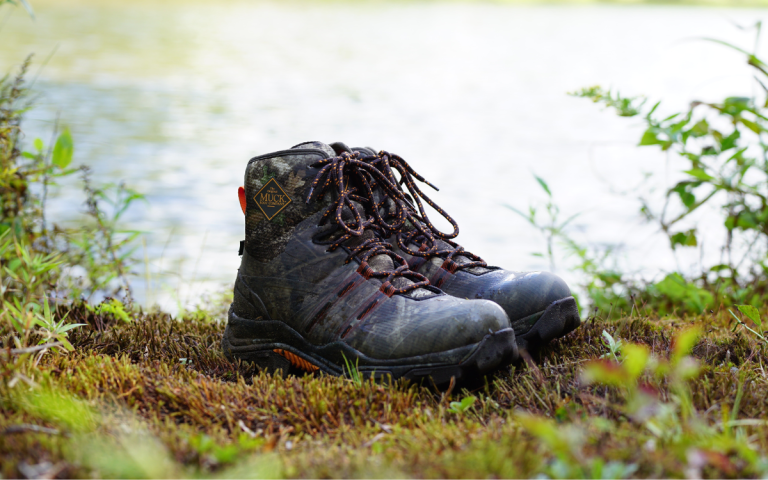
Pros
- Durable
- Comfortable
- Waterproof
- Lightweight
Cons
- Not the best choice for frigid weather
- Not much ankle support in rough terrain
Key Features
- Height: 8 inches
- Weight: 1.55 pounds each (men’s size 8)
- Rubber heel reinforcement for protection and durability
- Molded PU insert with memory foam
- bioDEWIX™ dry footbed insert topcover with NZYM™ for odor control and moisture management
The Muck Alpha Pursuit ankle boot is a newer offering from an incredibly well known boot brand. While Muck is a household brand, they gained that popularity from their knee-high rubber boots that are great for chores, hunting around waterways or swampy areas, and managing your scent in the deer woods. While they’re great in those aspects, I’ve always found most knee-high rubber boots to be hot, heavy, and cumbersome on long hikes into the big woods.
So, when Muck introduced the Alpha Pursuit ankle boot, I was excited to try them out. They’re lightweight, waterproof, and perform well as a hiking style hunting boot for folks like me who enjoy a long walk back to a hunting spot. The only issue I found was that the ankle support in rocky, mountainous terrain left me wanting more. They also won’t be the best option in late-season snowy hunts, but those were the only two pitfalls I could find.

Throughout the fall, spring, and summer, I put the Alpha Pursuits through a lot of long walks, skinny water crossings, and long sits in a tree stand. They were durable, retained their waterproofing, and the molded insert with memory foam makes them one of the more comfortable boots I’ve worn. My girlfriend also has a pair and stated, “It feels like I’m walking on a cloud compared to my old boots.”
For a serious mountain hunt, I’d likely opt for a different option with more ankle support, but for whitetail hunters that hunt close to home or camp, they’re a great option. If you’re tired of lugging around heavy knee-high boots in the deer or turkey woods, the Muck Alpha Pursuit ankle boots are a great choice at a very reasonable price.
Best Deer Hunting Boot: LaCrosse Alpha Evolution
Pros
- Warm
- Waterproof
- Comfortable
- Relatively scent-proof
Cons
- Heavy for hiking
Key Features
- Height: 17 inches
- Weight: 3.7 pounds each
- Upper Material: Rubber and neoprene
- Outsole: Vibram Icetrek
- Made in USA
- Insulation: 1600G Primaloft insulation
LaCrosse’s Alphaburly was widely considered the best deer hunting boot because it will reliably keep your feet warm and dry while in the treestand. Its rubber construction helps make it more scent-proof. It’s a heavy boot but most whitetail hunters don’t have to walk long miles or cross treacherously steep terrain to get to their deer stands. The Alpha Evolution is an improvement on the already very successful Alphaburly.
Most notably, the Evolution has a new Aerogel toe cap. LaCrosse says their aerogel is “the world’s lightest solid comprised of more than 95 percent air … This toe cap provides superior insulation with minimal bulk or weight and doesn’t pack down over time.” In other words, it will keep your toes warmer without adding much bulk to the boot.
Another new feature for the Evolution is that it’s now being made in the USA (with imported components). I’ve worn the new model while dog training and scouting for deer and can say the boots are super comfortable just like the Alphaburlys. I haven’t subjected them to sub-zero weather yet, but will this coming season.

The Evolution boots are rated as ideal for use in temperatures of 30 degrees to -70 degrees. If they perform like the Alphaburlys, my feet will stay toasty and dry all deer season. I’ve worn the same pair of Alphaburlys for more than six seasons of hard hunting for deer and field hunting waterfowl. They’re still warm and waterproof, though the Sitka Optifade paint job has all but faded away after years of abuse. I’m excited to retire that old pair and upgrade to the new Evolution boots this fall. —Alex Robinson, editor-in-chief
Most Comfortable Rubber Boot: Muddy Dv8 17
Pros
- Extremely comfortable
- Warm
- Stable in rugged terrain
- Insulated and uninsulated options
Cons
- Not ideal for super cold temps
Key Features
- Adjustable neoprene gusset
- Multiple camo and color patterns
- Height: 17 inches
- Weight: 5.6 pounds (uninsulated)
- Color options: Mossy Oak Bottomland, Veil Canyon Hybrid, Clay solid
The first thing you notice when you put on a pair of Muddy’s new boots is how incredibly comfortable they are. This is thanks to what Muddy calls “FeatherTech,” which is their footbed support system. Wearing these boots feels similar to slipping on a pair of ultra-cushy trail shoes (like a comfortable pair of Hokas, for example).

This is a big deal, as many rubber boots feel fine at first but generate blisters and hotspots once you start hiking. Not so with these Muddy boots. I hunted in them during the 2024 deer season and my feet stayed comfortable, warm, and dry when I was hiking into spots and while waiting on stand. There are two options with the Dv8 17s—insulated and non-insulated. I’ve worn both and I recommend going with the non-insulated if you mostly hunt in temps above freezing and to go with the insulated version if you mostly hunt in freezing temps and below.
These boots have neoprene at the top for comfort, a simple fastening strap in the back, and excellent outsoles that provide good traction in all terrain. — Alex Robinson
Best Light Rubber Hunting Boot: Le Chameau Chasseur
Pros
- Most comfortable rubber boot for hiking
- Durable
- Near-custom fit
Cons
- Expensive
Key Features
- Height: 15.5 inches
- Weight: 2.9 pounds each
- Upper Material: Rubber
- Outsole: Michelin Ultraflex
- Made in Morocco
- Insulation: Leather lining
- Variety of calf sizes
This Moroccan-made boot from French company Le Chameau might appear to be a little too stylish here on the list with a bunch of hardworking hunting boots. But at its core, this is an incredibly well-crafted, hand-made piece of hunting gear from a company that has been building boots for almost a century.
The Chasseur is a rubber boot with a full-grain leather lining. While most rubber boots are a pain to hike long distances in, this one is not. That’s because it’s designed to fit precisely. It is offered in eight different calf sizes and is designed with a stout zipper and snap button so the boot secures tightly to your foot and your leg. The shank is reinforced for better arch support. There’s abrasion-resistant padding incorporated around the foot, ankle, and heel area. In other words, these boots are built for comfort and performance.

I’ve worn the same pair of Chasseur boots for more than six seasons of hard hunting. They are my go-to turkey hunting boot. But I also wear them on early-season deer hunts. I also wore them to Southeast Alaska for an alpine blacktail deer hunt, where we hiked up from the beach through a soggy forest and then camped above treeline for several days before hiking back down with our backpacks full of venison. It was steep, slick terrain and the Chasseur boots held up admirably. My feet stayed dry and blister free even though it rained almost every day. I can’t imagine wearing any other rubber boot on a mountain hunt like that. They’re still just as waterproof as the first day I put them on. — A.R.
Best Elk Hunting Boot: Schnee’s Granite 200g
Pros
- Rugged
- Ideal for extended backcountry hunts
- Excellent support
- Excellent environmental protection
Cons
- Stiff and bulky
- Pricey
Key Features
- Height: 10 inches
- Weight: 2.35 pounds each (men’s size 10)
- Upper Material: 2.8mm top grain leather
- Outsole: Vibram Tsavo
- Made in Italy
Late season wilderness elk hunting is hard. I know—that’s like saying Everest is tall. But it is the most important fact to consider when picking a boot to lace on before ascending into the frigid snow-choked mountains. Schnee’s Granite series is built for the task. This Italian-made workhorse hits all the high notes for what is without doubt one of the most grueling types of hunting.
The 10-inch height of the Granites combined with their stiff construction and full rubber rand offer plenty of protection from rock, ice, and snow while providing the necessary support to carry heavy loads over uneven ground.

The boot is built with several refined touches that enhance their quality. The gasket between the lower boot body and upper minimizes the break-in period and improves comfort during steep climbs. The roller bearings in the lace eyelets make for smooth cinching of the laces, while a locking eyelet allows for precise control over lace tension. I’ve taken full advantage of this system numerous times, adjusting the pressure of my boots depending on whether I’m climbing, riding horses, or sitting for a prolonged glassing session.
The laces also snug the upper tight enough that you can traverse streams with minimal water intrusion, which is a comfort.
Though the insoles that come with the boot are very good, I swapped mine for Superfeet Hike Support Insoles, which has made for an unbeatable combination.
I prefer the 200-gram version, as it makes the boot more versatile for weather that isn’t frigid, but you can go all-in with the 600-gram model if you want extra insulation. I will jack up the warmth of my boots by going with Schee’s Tech Liner under a pair of wool or wool-blend socks. And in extreme cases I’ll throw a foot-warmer in there too and call it good. — J.B.S.
Best Classic Hunting Boot: Danner Pronghorn
Pros
- Versatile for everything from big-game to upland hunting
- Gore-Tex waterproof liner
- Easy to break in
Cons
- Not the best choice for steep or marshy terrain
- Requires conditioning for best performance
Key Features
- Height: 8 inches
- Weight: 1.6 pounds each (men’s 8.5)
- Upper Material: Full-grain leather
- Outsole: Vibram
- Made in Vietnam
- Available in uninsulated and insulated models (0 to 1200g Thinsulate)
I’ve been a Danner Pronghorn acolyte since I started hunting, inheriting 30-year-old hand-me-downs my dad had kept in good repair and later purchasing the modern iteration of the classic boot. The Pronghorn, now on its fifth generation, is an all around workhorse suitable for everything from summer treestand work to upland hunting to Western spot-and-stalk hunts for critters like, well, pronghorn. The only thing I haven’t laced up mine for is steep mountain hunting, since the boot isn’t stiff enough for extreme terrain or hauling heavy packs.

Even though these boots are leather, breaking them in isn’t really necessary—I was able to just wear mine out the door of my first Midwest scouting trip with them. Danner has a 365-day warranty on boots, although the Pronghorns are not eligible for the brand’s recrafting program, so you’ll have to take care to condition the leather each season and after particularly gnarly hunts so they last you a lifetime. — Natalie Krebs, executive editor
Best Mountain Hunting Boot: Lowa Tibet GTX
Pros
- Incredibly durable
- Medium-stiffness makes them a versatile mountain boot
Cons
- Not ideal for steepest terrain
Key Features
- Height: 8.5 inches (size 13)
- Weight: 2.5 pounds each
- Upper Material: Leather
- Outsole: Vibram Masai
- Made in Germany
- Full rubber rand
- Ball bearing lacing grommets and lacing lock cam
The Lowa Tibet GTX is one of the best mountain hunting boots on the market, and very popular with alpine deer, elk, and sheep hunters. It’s a traditional-style boot with a leather upper, rigid Vibram outsole, and a protective rubber rand around the base of the boot. It’s a medium-stiff boot that can handle rough, steep terrain, but isn’t uncomfortable when walking long distances with heavy loads. The lacing system allows the user to tension the foot and ankle lacing differently for an optimized fit.

I’ve used the Lowa Tibet GTX on many sheep hunts over the past 12 years and I know of some users who have close to a thousand hard miles on theirs. They’re durable and long-lasting, and ideal for hunting in steep country—though they aren’t quite ideal for extremely steep mountain goat-type terrain. — Tyler Freel, staff writer
Best Women’s Hunting Boot: Danner Wayfinder
Pros
- Versatile for species and terrain
- Lightweight compared to similar style boots
- Waterproof liner
Cons
- Require conditioning for best performance
Key Features
- Height: 8 inches
- Weight: 1.25 pounds each (women’s 10)
- Upper Material: Suede and nylon
- Outsole: Danner Wayfinder outsole
- Made in Vietnam
- Available in tan (uninsulated), Mossy Oak (400g Thinsulate), and Realtree camo (800g)
After years of wearing men’s hunting boots in my size (including Danner Pronghorns), I finally slipped on a pair of Wayfinders and realized why buying boots made specifically for women is a good idea. The Wayfinders are much lighter than comparable styles in men’s boots, and the fit just feels right (Danner describes the fit as “athletic”). Lacing up the Wayfinders is closer to slipping on a pair of hiking boots or trail running shoes, but with all the versatility of an 8-inch leather hunting boot.

I appreciate the natural, hunting color tones on this boot (none of the pink or purple that traditionally afflicts women’s camo). These boots are stiffer and more structured than the Danner Pronghorn, so they’ll take a little breaking in, but once you do they’ll serve you well. I’ve worn the Wayfinder for everything from summer deer scouting and treestand work to Hawaiian axis deer and high-alpine elk hunts. It wouldn’t be my go-to choice for hauling elk meat out of the backcountry, but it can do just about everything else. Technically these boots are suede instead of leather (with some nylon), but they wear in well and are much lighter than full-grain leather. Just be sure to waterproof and condition the suede as needed. — N.K.
Best Late-Season Whitetail Boot: Schnee Extreme 13
Pros
- Extremely warm
- Waterproof
- Durable
Cons
- Heavy
Key Features
- Height: 13 inches
- Weight: 6.6 pounds each
- Upper Material: Oil tanned top grain leather
- Outsole: Goodyear Advantage
- Made in USA (with imported products)
- 400g Thinsulate liner plus 600g Thinsulate built into rubber bottom
If you’re a Northcountry deer hunter and your feet get cold easily, you should invest in Schnee’s incredibly warm pac boots. The Extreme 13 integrates 1,000g of Thinsulate into its rubber bottom. The 13-inch leather upper will keep out the snow, slush, and water. They are rated to -20 degrees if you’re sitting still and -40 degrees if you’re walking around.

I’ve had a pair of the Extreme 10s for about a decade and have worn them on the very coldest late-season deer hunts in northern Wisconsin without getting cold. I’ve also worn them while ice fishing in sub-zero weather and never had my little piggies experience so much as a chill. If I were to do it over again, I’d go with the taller version for tromping through deep snow. Sure, these are spendy boots, but having warm feet on a frigid late-season deer hunt is priceless. — A.R.
Best Early Season Whitetail: Salomon XA Pro 3D
Pros
- Light
- Grippy
- Supportive, yet nimble
- Wide sizes available
Cons
- Wear out quickly
- Snug fitting, some people will need to go with a wide or size up
Key Features
- Weight: 13 ounces each
- Upper Material: Synthetic leather
- Outsole: Contagrip rubber
- Gore-Tex and non-Gore-Tex versions available
- Stack Height: 23.2mm (forefoot), 34.2mm (heel)
- Drop: 11mm
I have a very limited window to bowhunt in my home state. We get the month of October (four weekends) before the orange, muzzleloader-wielding army sends the deer underground. So it doesn’t matter if it’s still 85 degrees out, I’ll be hunting.
I generally hate hunting in rubber boots, especially in early season. I’m not as sneaky while wearing them, it’s hard to get a good purchase on climbing sticks, and they’re overall clunky footwear. So my choice for early-season whitetail hunting is the Salomon XA Pro 3D. They’re breathable, so your feet won’t sweat when it’s hot and then get chilled. And the upper is rigid enough to support your feet through side hills, treestand climbs, and deer drags.
The outsole is the key feature that separates it from other lightweight shoes. It’s just thin enough to allow you to feel the ground under your feet while you’re sneaking in close to a bedding area, but it’s thick enough that you’re not in agony while standing on a 1-inch wide climbing stick step—something I appreciate after hunting in my Altra Lone Peaks last season. I also like the quick lace system which makes it easy to tighten up when you’re on the move and loosen your laces in the stand.
The cons that come with using a light, breathable boot is that your feet will get wet if you walk through a dewy field or take a bad step crossing a creek. But to me, the trade off is worth it. The XA Pro 3Ds aren’t available in a mid-height anymore so they’re more of a trail running shoe. But if you want something similar in a boot format the XA Forces are a good option—the name stems from their tie to the Green Berets. — Scott Einsmann, gear editor
Best Duck Hunting Boot: Chene Slough Boot
Pros
- Waterproof
- Lighter and more comfortable than waders
- Great for early-season and mid-season hunts
Cons
- Belt loop clip broke
Key Features
- Height: 26 inches (when extended)
- Weight: 2.7 pounds each
- Upper Material: 3mm neoprene and four-layer wader nylon
- Outsole: Molded rubber
- Webbing clip connects to belt loops
- Made in China
This clever rubber boot utilizes 12 inches of wader material that you can cinch up to give you a hip-boot-style fit for wading through water. When you’re on dry ground, you can simply fold down the wader material to stay cool and comfortable.
Anyone who works on duck hunting properties, hunts shallow water during the early duck season, or hunts deer and turkeys in the swamp will immediately appreciate the ingenuity of this boot. Sometimes you just don’t want or need to wear a full chest wader. But often a regular rubber boot isn’t high enough for keeping water from splashing your knees and running down into your boot. That’s exactly when you need the Slough Boot.

I recently wore mine during the opening weekend of early teal season in Minnesota. I had scouted a shallow, mucky pothole that was full of bluewings, a little more than a half-mile from the road. The high temperature for opening day was a scorching 95 degrees. Rather than sweat to death in waders, I threw on my Slough Boots and got to hiking. I killed my limit of ducks and made it back to the truck before the heat hit, barely breaking a sweat.
My only critique of these boots is that I wish they had a better fastening system for the strap that connects to your belt loops. In one especially mucky section I had to yank hard to free my foot and I busted the thin metal clip. I’ve since replaced the clips with heavy-duty carabiners. — A.R.
Best for Extreme Mountain Terrain: HanWag Omega GTX
Pros
- Ideal for rugged mountain terrain
- Compatible with step-in crampons
Cons
- Not ideal for long hikes in flat country
Key Features
- Height: 10 inches (size 13)
- Weight: 3.25 pounds each (measured)
- Upper Material: Suede leather
- Outsole: Vibram Alpin
- Made in Germany
- Full rubber rand
- Ball bearing lacing grommets
- Crampon compatible
If I had to pick a leather boot that’s perfect for extreme alpine hunting for mountain goats or sheep in really tough terrain, it would be the HanWag Omega GTX. This is a heavy, ultra-stiff boot that’s made for climbing steep mountains. It has an excellent toothy sole and high rubber rand to protect the boot from shale and sharp rocks. It won’t be the best for hunts that require a lot of walking miles, but they’ll be unmatched in the steep stuff. They have a thick sole that might require some getting used to. The boots are compatible with step-in crampons for the most hazardous mountain conditions.
The Omega GTX has a modular fit, with a removable tongue insert to adjust the volume of the boot to your foot. I found that the boots don’t fit my feet well with the stock insoles, but with aftermarket insoles they are wonderful. If you’re looking for a bomb-proof boot for the most rugged terrain, it’s hard to go wrong with these. — T.F.
FAQs
There are a lot of great hunting boot makers in this lineup. If you’re not afraid to pay top dollar, look at boots from Crispi, Schnee’s, and Lowa. If you want a more affordable hunting boot, look at Danner and LaCrosse.
The LaCrosse Alpha Evolution boots are excellent for cold weather. The Schnee’s Extreme 13s are ideal for sub-zero weather conditions.
In wet weather, a rubber boot will keep you dry. You won’t find a more comfortable or well-designed rubber boot than the Le Chameau Chasseur.
Final Thoughts on the Best Hunting Boots
Yes, you can find more affordable boots out there that would probably serve you fine during fair-weather hunting. But if you’re a serious hunter you’re going to be out in the rain and cold. You’re going to climb steep, rugged terrain. You’ll hike far and wade swamps. You’ll stalk silently into bow range on that bedded buck. And to do all of that you’re going to need an arsenal of top-end boots that are able to match the terrain, conditions, and your own hunting intensity. And because of that, all of the best hunting boots on this list are well worth the investment.
- Best Overall: Crispi Nevada Non-Insulated GTX
- Great Buy: Oboz Bridger Insulated
- Best Barefoot Boot: Vivobarefoot Tracker ESC
- Most Versatile Hunting Boot: Meindl Eurolight Hunter 300
- Best Deer Hunting Boot: LaCrosse Alpha Evolution
- Most Comfortable Rubber Boot: Muddy Dv8 17
- Best Light Rubber Boot: Le Chameau Chasseur
- Best Elk Hunting Boot: Schnee Granite 200g
- Best Classic Hunting Boot: Danner Pronghorn
- Best Mountain Hunting Boot: Lowa Tibet GTX
- Best Women’s Hunting Boot: Danner Wayfinder
- Best Late-Season Whitetail Boot: Schnee Extreme 13
- Best Early Season Whitetail: Salomon XA Pro 3D
- Best Duck Hunting Boot: Chene Slough Boot
- Best for Extreme Mountain Terrain: HanWag Omega GTX

